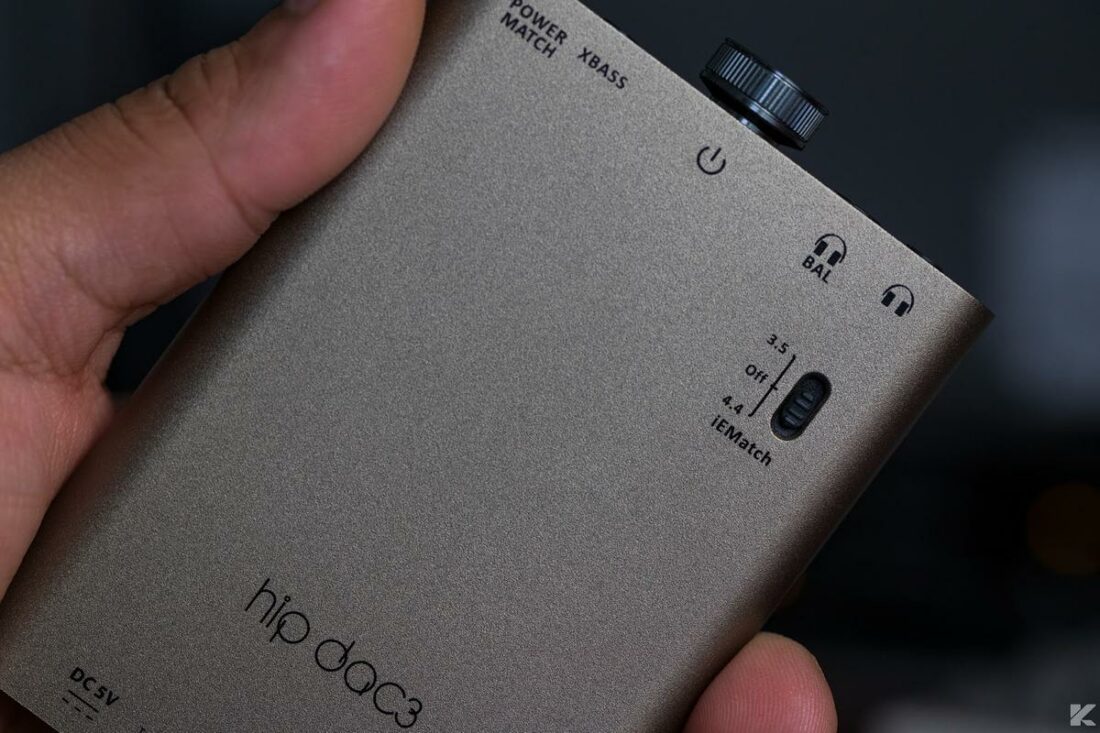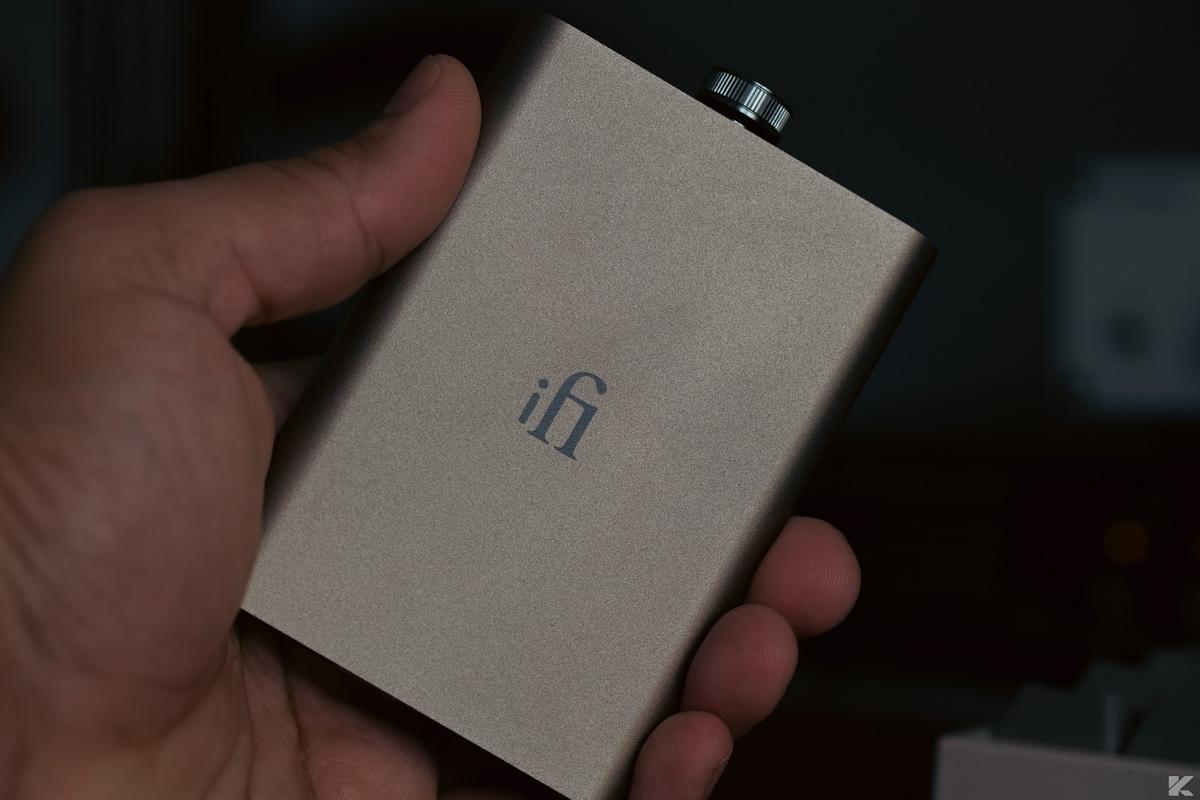Despite connectivity limitations, the addition of IEMatch makes the hip-dac 3 a compelling upgrade.
- Signature “hip-dac” design language with excellent fit and finish
- The volume knob is a joy to use
- IEMatch finally adds a much-needed feature
- Type-C instead of full-size USB for data
- The lack of Bluetooth is a bummer
- Without IEMatch, the hip-dac 3 has a high noise floor with sensitive loads
- No line-in or line-out
Designing an entry-level product is a balancing act. The idea is to give consumers enough to get hooked to the brand and omit some “perks” to entice them toward higher-end offerings.
The OG hip-dac perfectly fulfilled that role. It did not have IEMatch, advanced connectivity options, or an impressive spec sheet. What iFi focused on instead was exceptional build, unique design language, and a warm, analog sound that alludes to the brand’s tuning philosophies.
The hip-dac 2 was a very subtle refresh. The headlining feature was the inclusion of MQA, but that ship has since sunk. Meanwhile, the competition has been steadily catching up in terms of features and connectivity options.
The hip-dac 3 adds IEMatch while increasing the battery life considerably, both of which are welcome improvements. Are they enough to elevate the hip-dac 3 above the rest of the competition? That answer requires a bit more explanation.
Read on.
Unboxing and First Impression
Design and Build
The hip-dac 3 retains the same design language and chassis as the previous generations.
I love the form factor and feel in hand.
It’s not as portable as some dongles out there, but I think iFi has struck a nice “stackable” solution here to use alongside a phone. The sandblasted aluminum has a premium finish that belies the price tag.

The bottom of the device now has the IEMatch switch that can be toggled between the single-ended and balanced outputs.

A special mention should go to the volume pot that also acts as a power button. It’s got the perfect amount of friction, and minute adjustments are easy to make. The front buttons can be a bit stiff, but it’s not a big deal for me.
In the end, there is absolutely nothing that I can fault about the build and design here, which is a testament to iFi Audio’s attention to detail in these aspects.
Connectivity
The hip-dac 3 has a type-C input for USB Audio and 3.5mm and 4.4mm balanced outputs for analog out. The device also charges via type-C, which is a much-requested feature. The LED underneath the charging port shows the remaining battery life.
The lack of Bluetooth is a major omission.
Additionally, there are no analog line-in or optical/coax inputs.
I understand iFi’s reasoning about product segmentation. For example, the iFi Go Blu is Bluetooth only and priced similarly to the hip-dac 3. Moreover, the addition of BT would surely jack up the price.
One can always hope this is something iFi considers for the next generation of hip-dacs.
Battery
Battery life is very good in my experience, as I get 8-10 hours of playback time with high-resolution FLAC files (24-bit, 96 kHz) and high-impedance headphones like the HD 650.
It is not quite the 12 hours that iFi states on the product page, but I believe that number may be achievable with a less demanding pair of IEMs and regular bitrate mp3 files.
A full recharge takes almost 3 hours.
Controls
The central volume pot remains the most easily accessible control, with the xBass and PowerMatch buttons being more recessed.

The two LEDs surrounding the volume pot indicate the sampling rate (colors listed in the manual). The small white xBass and PowerMatch LEDs light up whenever these options are engaged.

The power and data lines are separated physically, with two USB type-C ports handling different tasks. Overall, it is a minimal control scheme that’s very easy for new users to get accustomed to.
Under the Hood
iFi Audio is highly adept at maximizing the BurrBrown chipset’s performance, and it reappears on the hip-dac 3.
The BB DSD1793 chipset offers native DSD encoding and, with the updated XMOS controller, can now decode MQA files at a hardware level.
Another interesting aspect is the fully analog potentiometer.
While it avoids some of the limitations digital potentiometers may have, it may degrade over time.
The Global Master Timing clock is the same one used in the hip-dac 2, and so is the amp section that utilizes quad JFET OV4627 op-amps (customized for iFi Audio). The amp circuit also uses a dual-mono design for the balanced output.
Other extras include the xBass feature, an analog EQ that aims to “fix” the sub-bass roll-off issue on open-back headphones.
The other feature is the PowerMatch button that acts as a gain switch for headphones (iFi advises keeping it off for sensitive IEMs). I noticed an increase in hiss when turning it on for sensitive IEMs.
Speaking of power outputs, the hip-dac 3 outputs 400 mW into 32 ohms from the balanced out and 280 mW into 32 ohms from the single-ended out (which also supports their proprietary S-balanced tech).
The voltage swing can go as high as 6.3Vrms from the balanced out, which should aid in optimally driving high-impedance dynamic driver headphones.
Lastly, the IEMatch circuitry adds some impedance to suppress the amp section’s noise floor, which works wonders with very sensitive IEMs. One thing to note is the higher-than-nominal output impedance with the IEMatch, which can go up to 4.5 ohms.
How Does the iFi hip-dac 3 Sound?
The general sound signature of the iFi hip-dac 3 is warm-neutral.
It has the characteristic iFi Audio warmth with smooth treble and an engaging midrange. The bass is mostly neutral but can be pushed higher with the xBass switch.

The previous two hip-dac generations had somewhat narrow staging. The hip-dac 3 does not change much without IEMatch, but the stage seems to get wider with IEMatch engaged, at least on the Bonneville.
This is likely due to the vanishingly low noise floor with IEMatch engaged. As such, the hip-dac 3 is a massive improvement in driving sensitive and very low-impedance IEMs over the previous two generations.
As always, talking about the sound of source gear without discussing how they can drive certain headphones and IEMs is somewhat futile, so let’s get right into it.
Pairing Notes
The Campfire Bonneville hiss noticeably without IEMatch, but flicking the switch completely silences the unwanted noise. The overall presentation is somewhat mellowed out in the treble region, which helps tame some of Bonneville’s mid-treble peakiness.

The Simgot EA1000, meanwhile, only display some minor hiss when the volume pot is pushed very high to unhealthy listening levels and the music has quiet passages.

Finally, the Sennheiser HD 650 sound very good with the high voltage swing, making the bass and mids sound full-bodied. The HD 650 definitely “scale” with higher powered amps, but the hip-dac 3 does a good job for a mid-range portable device.
One pair of IEMs that the hip-dac 3 does not work well with is the Final E5000. These are incredibly hard to drive, and the somewhat warm tuning of the hip-dac 3 does not mesh well with the already warm E5000.
Comparisons
iFi hip-dac 3 vs iFi hip-dac 2
The iFi hip-dac 2 is essentially the same as the hip-dac 3, with the significant exclusion of the IEMatch switch. The type-C data port is a quality-of-life improvement on the newer model.
Sonically, I struggle to differentiate them using the usual headphones, but sensitive IEMs widen the gap. The inherent noise of the amp section is still there on the hip-dac 3, but now there is a way to suppress it, something that the hip-dac 2 just cannot do.
Other than that – they are very close to each other. If your primary use case is somewhat less sensitive IEMs and headphones, you probably won’t notice much change with the hip-dac 3.
I recommend that new buyers go for the hip-dac 3 as it’s more versatile.
Where to Buy
Who Should Buy This?
Anyone looking for a portable, battery-powered DAC-amp to power high impedance dynamic driver headphones and moderately sensitive IEMs.
Final Thoughts
It’s pretty apparent that the IEMatch is somewhat of a “saving grace” for the hip-dac 3, as otherwise, it is essentially the same as the hip-dac 2, USB type-C port notwithstanding. Even then, it’s a more significant improvement than the change from the OG hip-dac to the hip-dac 2.
In a way, iFi Audio’s “if it ain’t broke, don’t fix it” approach is understandable from a business perspective. It does not alienate existing users, the incremental additions have practical benefits, and the price can be kept mostly static across generations.
The hip-dac 3 is a solid product overall unless you are miffed about the high noise floor typical of the hip-dacs (barring IEMatch), which I hope iFi addresses someday. Perhaps with the hip-dac 4?
One can hope, after all.
Company Overview
iFi Audio is a UK-based audio company specializing in producing DACs, headphone amplifiers, and power conditioners. Established in 2012, iFi Audio has built up a loyal following and offers a varied range of products across different price points.
What’s in the Box?
- iFi hip-dac 3
- USB-C to USB-C cable
- USB-C to USB-A cable
Technical Specifications
- Form: Portable DAC-Amp
- Weight (g): 135 g
- Frequency Response (Hz): 20 Hz – 45 KHz
- Source Jack: 3.5mm, 4.4mm
- Battery Life (hrs): 12
- Mic: N
